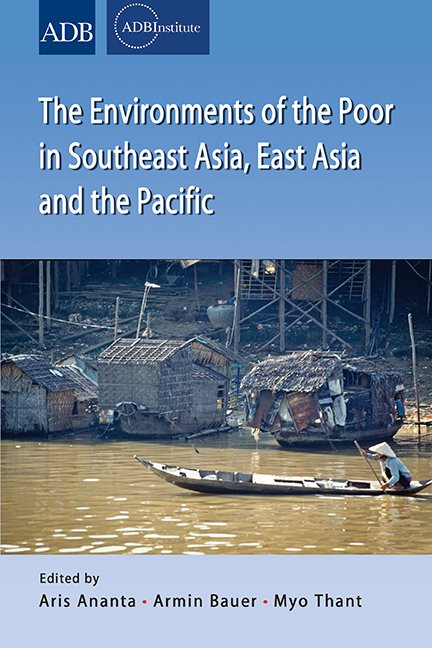Book contents
- Frontmatter
- Contents
- Preface
- List of Contributors
- Part I OVERVIEW
- Part II EAST ASIA (People's Republic of China and Republic of Korea)
- Part III PACIFIC ISLANDS
- Part IV MAINLAND SOUTHEAST ASIA (Cambodia, Thailand, Vietnam)
- Part V ARCHIPELAGIC SOUTHEAST ASIA (Indonesia, Malaysia, Philippines)
- 13 The Political Economy of Environmental Policy in Indonesia
- 14 Prospering in Environmental Degradation: An Illustration from an Upland Area, South Kalimantan, Indonesia
- 15 Making a Living in the Face of Environmental Change: A Case in an Indigenous Community in Sarawak, Malaysia
- 16 The Response of Rural Coastal Households to Typhoon Milenyo in the Philippines
- 17 Life Along Manila's Flooding Rivers
- 18 Quantifying the Health Risks from Pathogens in the Flood Water in Metro Manila
13 - The Political Economy of Environmental Policy in Indonesia
from Part V - ARCHIPELAGIC SOUTHEAST ASIA (Indonesia, Malaysia, Philippines)
Published online by Cambridge University Press: 21 October 2015
- Frontmatter
- Contents
- Preface
- List of Contributors
- Part I OVERVIEW
- Part II EAST ASIA (People's Republic of China and Republic of Korea)
- Part III PACIFIC ISLANDS
- Part IV MAINLAND SOUTHEAST ASIA (Cambodia, Thailand, Vietnam)
- Part V ARCHIPELAGIC SOUTHEAST ASIA (Indonesia, Malaysia, Philippines)
- 13 The Political Economy of Environmental Policy in Indonesia
- 14 Prospering in Environmental Degradation: An Illustration from an Upland Area, South Kalimantan, Indonesia
- 15 Making a Living in the Face of Environmental Change: A Case in an Indigenous Community in Sarawak, Malaysia
- 16 The Response of Rural Coastal Households to Typhoon Milenyo in the Philippines
- 17 Life Along Manila's Flooding Rivers
- 18 Quantifying the Health Risks from Pathogens in the Flood Water in Metro Manila
Summary
In Indonesia, there is widespread awareness of climate change and environmental problems, at least in academia, policy-making, civil society organizations, and NGOs. However, the ways climate change and the environment affect poverty are not so well understood. Indonesia, like many other countries, is preoccupied with achieving economic growth in a business-as-usual manner. The government emphasizes social protection rather than reducing vulnerabilities and improving livelihoods of the poor through a green economy. In this essay, we review the current discussion on the economics of environmental protection in Indonesia, especially with regards to climate change, and propose ways to fill in certain gaps between discourse and policy. We also discuss the poverty situation of Indonesia and highlight its relationship with the environment. Finally, we discuss the policy possibility of using the environment-climate connection as a way to accelerate poverty reduction. In particular, we argue that policies that take into account climate change and its effect on poverty should be applied at three different levels: micro, macro (national), and global (international).
THE ENVIRONMENT — POVERTY CONNECTION IN INDONESIA
Poverty in Indonesia has been decreasing (Figure 13.1), although there were a few spikes following the Asian Financial Crisis in 1997/98 and the rice and fuel price increases in 2005. As of February 2010, the poverty headcount index in Indonesia is around 13.3 per cent. 1 (Figure 13.1 depicts GDP growth rates and the open unemployment rates during 1998 to 2010.) The Asian Financial Crisis hit the country severely, resulting in a 13 per cent contraction. Slowly the country recovered, reaching its pre-crisis level in 2007, after ten years. The recent global financial crisis turned out to be far less damaging. In fact, Indonesia (along with China and India) was quite resilient, with a growth rate of 4.5 per cent in 2009, while most countries in the world experienced a contraction or near-zero growth.
Unemployment rate dynamics, on the other hand, reflect the four phases of the labour market in Indonesia, namely “growing rapidly” (1990–97, not shown on the figure), “crashing and coping” (1997–99), “jobless growth” (1999–2003), and “job recovery” (2003–08) (World Bank 2010).
- Type
- Chapter
- Information
- Publisher: ISEAS–Yusof Ishak InstitutePrint publication year: 2013



